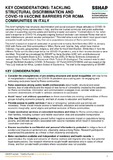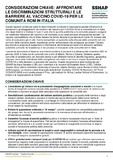Key Considerations: Tackling Structural Discrimination and COVID-19 Vaccine Barriers for Roma Communities in Italy
Considerazioni chiave: affrontare le discriminazioni strutturali e le barriere al vaccino covid-19 per le comunità rom in italia
| dc.contributor.author | Sarafian, Iliana | |
| dc.coverage.spatial | Italy | en |
| dc.date.accessioned | 2022-05-24T11:51:54Z | |
| dc.date.available | 2022-05-24T11:51:54Z | |
| dc.date.issued | 2022-05-23 | |
| dc.identifier.citation | Sarafian, I. (2022) Key Considerations: Tackling Structural Discrimination and COVID-19 Vaccine Barriers for Roma Communities in Italy, Social Science in Humanitarian Action Platform (SSHAP), DOI: 10.19088/SSHAP.2022.014 | en |
| dc.identifier.citation | Sarafian, I. (2022) Considerazioni chiave: affrontare le discriminazioni strutturali e le barriere al vaccino covid-19 per le comunità rom in italia, Social Science in Humanitarian Action (SSHAP), DOI: 10.19088/SSHAP.2022.024 | it |
| dc.identifier.uri | https://opendocs.ids.ac.uk/opendocs/handle/20.500.12413/17421 | |
| dc.description.abstract | This brief highlights how structural discrimination and social exclusion shape attitudes to COVID-19 vaccines among Roma communities in Italy, and the role trusted communal and public authorities can play in supporting vaccine uptake and tackling broader exclusions. Contradictions in the Italian state’s response to COVID-19, alongside ongoing forms of exclusion can increase Roma mistrust in state initiatives and prevent vaccine participation. This brief aims to aid and inform local government and public health authorities in Italy that serve populations inclusive of Roma communities. This brief is based on research conducted in-person and remotely from November 2021 to January 2022 with Roma and Sinti communities in Milan, Rome and Catania, Italy, which have distinct historical, linguistic, geographical, religious, and other forms of identification. Similarities in how the different Roma communities experience the COVID-19 pandemic, and in their vaccine decisions were identified. This brief was developed for SSHAP by Iliana Sarafian (LSE) with contributions and reviews from Elizabeth Storer (LSE), Tabitha Hrynick (IDS), Dr Marco Solimene (University of Iceland) and Dijana Pavlovic (Upre Roma). The research was funded through the British Academy COVID-19 Recovery: G7 Fund (COVG7210058). Research was based at the Firoz Lalji Institute for Africa, London School of Economics. The brief is the responsibility of SSHAP. | en |
| dc.description.abstract | Questo rapporto evidenzia come le discriminazioni strutturali e l'esclusione sociale influenzino le percezioni e gli atteggiamenti nei confronti del vaccino per il COVID-19 tra le comunità rom in Italia. Uno degli obiettivi è mettere in luce il ruolo che le autorità pubbliche e le comunità possono svolgere nel sostenere l'adozione del vaccino e nel contrasto ai più ampi processi di esclusione sociale.1 Le risposte contraddittorie che lo Stato italiano ha fornito durante la pandemia di Covid-19, insieme alle forme di esclusione già in atto, hanno comportato un aumento della sfiducia delle comunità rom nei confronti delle iniziative statali, impattando anche sull’adesione alla campagna vaccinale.2 Questo documento si propone di supportare e informare le amministrazioni locali e le istituzioni sanitarie pubbliche coinvolte nell’assistenza e nei processi di inclusione delle comunità rom in Italia. Il presente documento si basa su una ricerca condotta di persona e a distanza dal novembre 2021 al gennaio 2022 in Italia con le comunità rom e sinti di Milano, Roma e Catania. Sebbene queste comunità si caratterizzino per diversità storica e per differenti forme di identità linguistica, geografica, religiosa, sono state individuate delle somiglianze nel modo in cui hanno vissuto la pandemia di COVID-19 e nelle decisioni a proposito del vaccino. Questo documento è stato sviluppato per SSHAP da Iliana Sarafian (LSE) con i contributi e le revisioni di Elizabeth Storer (LSE), Tabitha Hrynick (IDS), Marco Solimene (University of Iceland), Dijana Pavlovic (Upre Roma) e Olivia Tulloch (Anthrologica). La ricerca è stata finanziata dalla British Academy COVID-19 Recovery: G7 Fund (COVG7210058) e si è svolta presso il Firoz Lalji Institute for Africa, London School of Economics. La sintesi è di responsabilità di SSHAP. | it |
| dc.description.sponsorship | Foreign, Commonwealth & Development Office (FCDO) | en |
| dc.description.sponsorship | Wellcome Trust | en |
| dc.language.iso | en | en |
| dc.publisher | SSHAP | en |
| dc.rights.uri | http://creativecommons.org/licenses/by/4.0/ | en |
| dc.subject | Health | en |
| dc.title | Key Considerations: Tackling Structural Discrimination and COVID-19 Vaccine Barriers for Roma Communities in Italy | en |
| dc.title | Considerazioni chiave: affrontare le discriminazioni strutturali e le barriere al vaccino covid-19 per le comunità rom in italia | it |
| dc.type | Series paper (non-IDS) | en |
| dc.rights.holder | SSHAP | en |
| dc.identifier.doi | 10.19088/SSHAP.2022.014 | |
| dc.identifier.doi | 10.19088/SSHAP.2022.024 | |
| dcterms.dateAccepted | 2022-05-23 | |
| rioxxterms.funder | Default funder | en |
| rioxxterms.identifier.project | Default project | en |
| rioxxterms.version | VoR | en |
| rioxxterms.versionofrecord | 10.19088/SSHAP.2022.014 | en |
| rioxxterms.funder.project | 9ce4e4dc-26e9-4d78-96e9-15e4dcac0642 | en |



